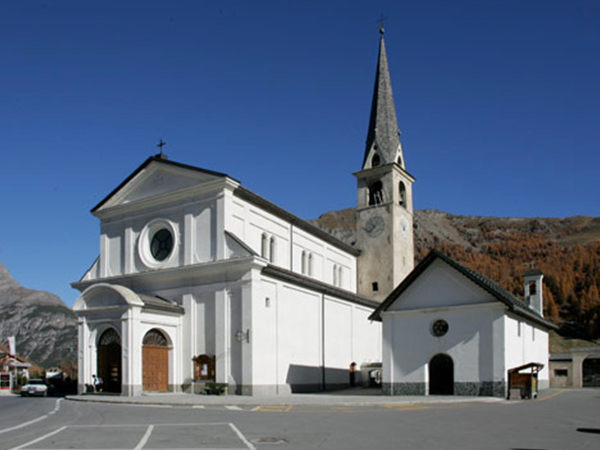Parish Church of Santa Maria Nascente
CONTACT: www.livigno.eu
DIRECTIONS: located just a few metres into the pedestrian area, the Church of Santa Maria Nascente can be reached by car or on foot.
INTERESTING FACT: the church is currently dedicated to the Birth of the Virgin Mary, which is celebrated on 8 September, but was dedicated simply to St. Mary in the distant past. The change occurred following a switch in the date that the consecration of the church was celebrated – until at least 1570, it was celebrated on 7 September.
DESCRIPTION:
The inscription on the arch of the apse reads: “Ecclesia ista aedificata fuit elemosynis et labore populi 1884-1887 e fu consacrata il 21 Luglio 1892“ (This church was built in 1884-1887 through the labour and donations of residents and was consecrated on 21 July 1892). Construction of the nearby parish house, on the other hand, began in 1635. The interior of the church features a nave without side aisles and an octagonal apse. Each of the six shallow chapels along the sides has an altar, almost all of which are dedicated to the Virgin Mary. An arched passageway connects the chapels. The spacious chancel contains the main altar, which holds a beautiful tabernacle decorated with four bas-relief panels depicting scenes from the life of the Virgin: the Birth of the Virgin Mary, the Annunciation, the Visitation and the Presentation of Mary. The first two side chapels are particularly interesting since they contain small wooden altarpieces that were built by the Carmelites and the Confraternity of the Rosary (1757-58). The altarpiece for the altar of Our Lady of Mount Carmel is made of carved gilt wood and has the shape of a large niche flanked by four columns, two of which are spiral columns. A devotional statue of the Virgin and Child stands on a pedestal inside the niche, surrounded by cherubs that support the crown and statues of St. Simon Stock and St. Teresa of Ávila. The altarpiece for the altar of the Rosary consists of four columns (three of which are spiral) that enclose sculptures of St. Peter and St. Paul, with a small statue of the Virgin above. Depictions of the Mysteries of the Rosary are painted on the three sides. There is an interesting inscription on the wooden altar frontal, which reads: "Virgo mater ave, qua mundus solvitur ave; sit semper sine ve, qui tibi dicit ave - 1751" (Hail Mary, through whom the world was freed from its woes, may those who Hail you be forever without woes). The second altar to the right, called the altar of the Dead, has souls in Purgatory painted on its wooden altar frontal. The next altar is dedicated to Our Lady of Lourdes and was built in 1908 to mark the 50th anniversary of the appearance of the Virgin to St. Bernadette.




